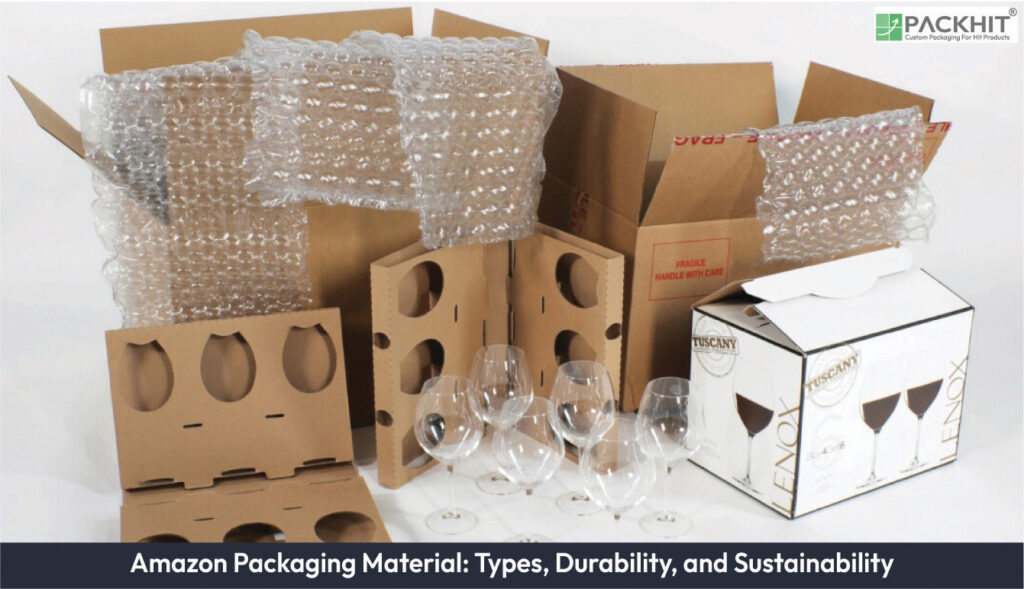Amazon packaging materials encompass a diverse range of substrates and designs engineered to meet the demands of e-commerce logistics, product protection, and environmental sustainability. These materials include corrugated, kraft, plastic, and other biodegradable alternatives, each selected based on specific performance attributes such as tensile strength, moisture resistance, and recyclability. The durability of Amazon’s packaging is optimized through rigorous testing protocols, ensuring that products remain intact during transit while minimizing material waste. Sustainability initiatives, including the use of recycled content, lightweight designs, and compostable options, align with Amazon’s commitment to reducing its carbon footprint.
What Types of Packaging Materials Does Amazon Use?
Amazon utilizes a variety of packaging materials tailored to the diverse range of products it ships. These materials can be broadly categorized into paper-based, plastic-based, and biodegradable options, each serving distinct functional roles within the supply chain.
The types of packaging materials used by Amazon are given below:
Corrugated Cardboard
Corrugated for Amazon packaging is the foundation of its shipping system, widely employed for its high strength-to-weight ratio and superior protective qualities. This material features a fluted corrugated layer sandwiched between two flat linerboards, creating a robust structure capable of withstanding compressive forces. Ideal for safeguarding fragile and heavy items, corrugated cardboard absorbs shocks effectively during transit. Amazon further enhances its sustainability by incorporating recycled fibers into this packaging, reducing the need for virgin materials and aligning with its environmental goals.
Kraft Paper
Kraft paper material in Amazon’s packaging is widely used for its strength, flexibility, and eco-friendly properties. Derived from wood pulp through the kraft process, this material is highly durable and resistant to tearing, making it suitable for various applications such as mailers, wrapping, and cushioning. Amazon incorporates kraft paper into its packaging to enhance recyclability and reduce reliance on plastic-based alternatives. Many kraft-based materials also include recycled fibers, aligning with Amazon’s sustainability goals. Lightweight yet robust, kraft paper provides effective protection for products while minimizing environmental impact and shipping weight.
Plastic
Amazon’s plastic packaging is utilized for its versatility, durability, and moisture resistance. Common forms include polyethylene mailers, air pillows, and bubble wrap, which provide lightweight yet effective protection for products. While these materials ensure product safety during transit, Amazon is actively working to reduce reliance on traditional plastics by incorporating recycled content and exploring biodegradable alternatives, aligning with its broader sustainability goals.
Biodegradable and Compostable Materials
In response to growing environmental concerns, Amazon has incorporated biodegradable and compostable materials into its packaging portfolio. Examples include plant-based films and compostable mailers made from polylactic acid (PLA). These materials decompose under industrial composting conditions, reducing long-term environmental impact.
How Durable Are Amazon’s Packaging Materials?
The durability of Amazon’s packaging materials is a critical factor in ensuring product integrity during transit. Durability is assessed through a combination of material properties, design features, and standardized testing protocols.
Material Strength and Resilience
Corrugated cardboard offers high compressive strength, making it resistant to crushing under load. Paper-based mailers, while less robust, are engineered with tear-resistant kraft paper to withstand handling stresses. Plastic films provide tensile strength and puncture resistance, ensuring that sharp or irregularly shaped items remain secure.
Testing Protocols
Amazon employs ISTA (International Safe Transit Association) testing standards to evaluate the performance of its packaging materials. These tests simulate real-world shipping conditions, including vibration, compression, and impact, to ensure that packaging can withstand the rigors of e-commerce logistics.
Design Features
Innovative design features, such as reinforced edges, self-sealing adhesives, and tamper-evident closures, enhance the functional durability of Amazon’s packaging. These features reduce the likelihood of damage during transit while maintaining ease of use for customers.
What Sustainability Measures Are Integrated into Amazon’s Packaging?
Amazon’s sustainability initiatives in packaging focus on reducing material usage, increasing recyclability, and incorporating renewable or recycled content. These measures are part of the company’s broader “Climate Pledge” to achieve net-zero carbon emissions by 2040.
Lightweight Packaging Designs
Amazon has adopted lightweight packaging designs to minimize material consumption and reduce shipping emissions. For instance, the transition from corrugated boxes to paper-based mailers for certain products has significantly decreased packaging weight.
Recycled Content
Many of Amazon’s packaging materials, including corrugated cardboard and paper mailers, incorporate recycled fibers. This practice reduces the demand for virgin materials and supports the circular economy.
Recyclability and Compostability
Amazon prioritizes the use of materials that are either recyclable or compostable. For example, its paper-based mailers and cardboard boxes are widely accepted in curbside recycling programs. Compostable materials, such as PLA-based mailers, offer an alternative for regions with industrial composting facilities.
Frustration-Free Packaging
The “Frustration-Free Packaging” program aims to eliminate unnecessary packaging layers and ensure that all materials are 100% recyclable. This initiative not only reduces waste but also enhances the customer experience by simplifying the unboxing process.

